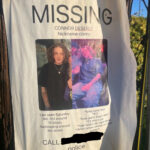The quiet suburbs of Springfield, Illinois, are shattered by a terrifying phenomenon: teenagers are plagued by nightmares. Best friends Tina and Nancy realize they share a terrifying dream figure – a grotesquely burned man in a tattered red and green sweater, wielding a razor-fingered glove. When Tina is brutally killed in her bed, suspicion immediately falls on her boyfriend Rod, the only one present at her death. Rod vehemently denies involvement, confessing to Nancy that he too is tormented by nightmares of a knife-fingered assailant. Nancy begins to suspect a sinister force at play, a boogeyman invading their very dreams.
Rod’s subsequent death in his jail cell solidifies Nancy’s fear: a phantom killer is hunting them in their sleep. Concerned for her daughter’s sanity, Nancy’s mother takes her to a sleep clinic for monitoring. Nancy awakens from a nightmare screaming, a bloody gash appearing on her arm, clutching a battered fedora pulled directly from her dream. The hat bears a chilling name tag: Fred Krueger. Nancy’s mother recognizes the name, revealing a dark secret from the town’s past. Years ago, Fred Krueger was a notorious child murderer who terrorized Springfield. Released on a technicality, the parents of his victims, including Nancy’s, took the law into their own hands, burning Krueger alive. Now, Fred Krueger is back, not in the flesh, but as a vengeful spirit, preying on the children of those who killed him. Nancy understands she must confront this nightmare made real to save herself and her friends on Elm Street.
Revisiting A Nightmare On Elm Street recently, its enduring power remains undeniable. While the acting occasionally shows its age and the film bears slight visual marks of its era, it’s still a remarkably effective horror movie. Its genius lies in its inescapable premise. Unlike countless horror films where victims willingly stumble into danger, A Nightmare On Elm Street traps its characters in the unavoidable act of sleeping. Even the most dedicated insomniac knows sleep is inevitable. We can’t fault these characters for dream-induced peril; who hasn’t experienced bizarre, uncontrollable dreams? In this nightmare, however, control rests solely with Freddy Krueger.
Robert Englund’s portrayal of Freddy Krueger is iconic. Before him, horror boogeymen were often silent, masked figures, imposing through sheer size and anonymity. While effective in their own right, Englund revolutionized the archetype. He crafted a boogeyman with personality, a terrifying smartass. Freddy, scarred and disfigured, with questionable fashion sense, possesses a chilling charisma. He doesn’t just kill; he toys with his victims, engaging in sadistic banter, flirting, humiliating, and reveling in his power. He forces Tina to witness him mutilate himself, grinning like a macabre uncle performing a twisted magic trick. He invades Nancy’s reality via a grotesque tongue-through-telephone intrusion. While his male victims might initially escape his twisted humor, the sequels more than compensate, showcasing the full breadth of Freddy’s dark wit.
A Nightmare On Elm Street is a groundbreaking film, brimming with innovative special effects, unsettling sound design – the scraping of metal claws, the terrifying bleating of baby goats – and a haunting score. The boiler room set is particularly disturbing, complete with hissing pipes and dripping chains, creating an atmosphere of palpable dread. The film also marks the debut of a young Johnny Depp, sporting iconic 80s feathered hair. While his character is worlds away from Captain Jack Sparrow, Depp’s inherent talent is already evident.
This film rightly remains the pinnacle of the Elm Street franchise, overshadowing even the better sequels and certainly the weaker installments. But regardless of the movie’s overall quality, Freddy Krueger himself is always compelling, a horror icon who continues to terrify and fascinate.

